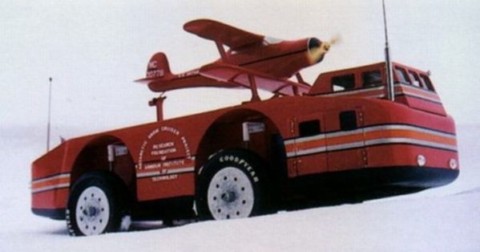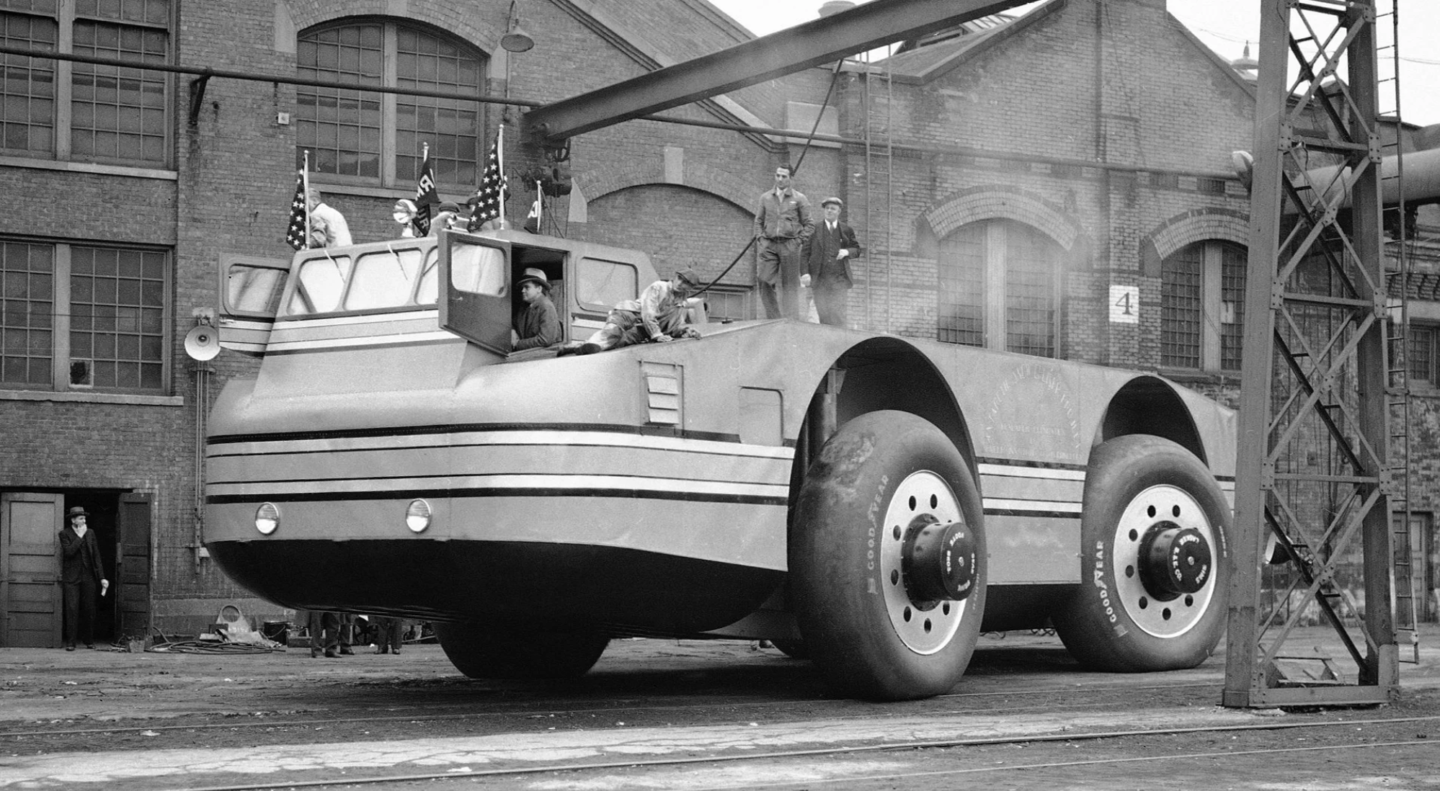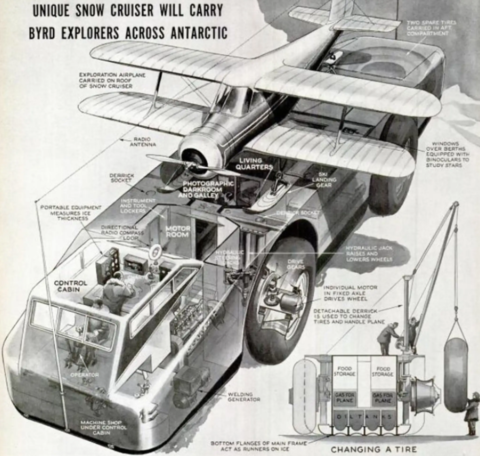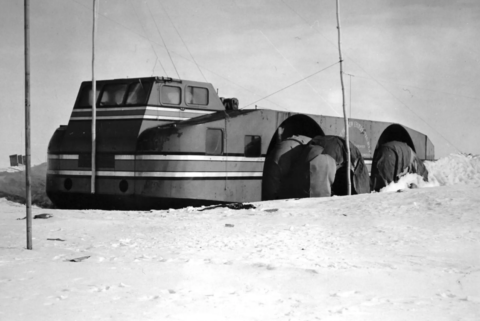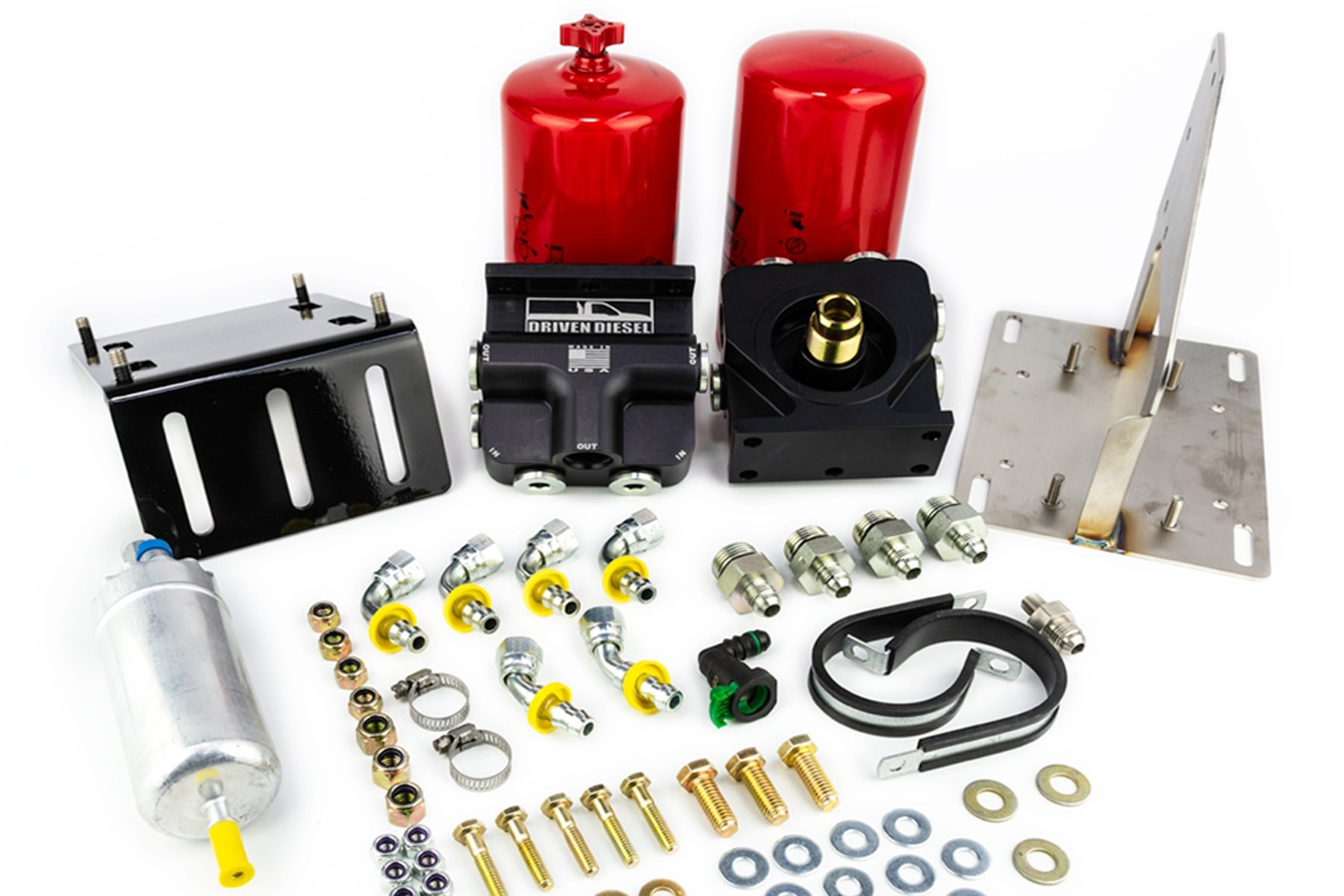If that title didn’t explain it well enough, there is a massive antarctic exploration vehicle that is lost somewhere at the bottom of the world. You read that right. A diesel-powered, earthmover sized vehicle that was capable of withstanding an extraordinary climate and was suppose to trek across the wastelands of Antarctica.
In 1939, the planners of the United States Antarctic Service Expedition questioned how they would manage to conquer a trip of this magnitude. Well, for a guy named Thomas Poulter, the designer of this new to you “vehicle”, they needed said vehicle. Or so he thought. This is something he accidentally drew up in his head after a near death experience. I give to you, the Antarctic Snow Cruiser.
Poulter, in a previous expedition to the bottom of the world after being trapped by weather at a remote Antarctic base, nearly died. “If only that base was mobile, maybe my life would have never been in danger,” he thought. Well, in the mid-1930s, in Chicago, Illinois, he pitched his remote base idea to the Research Foundation of the Armour Institute of Technology.
Coming To Life
He must’ve had a really good selling pitch because in August of 1939, at the Pullman Company in Chicago, construction began. In only 11 weeks, the Snow Cruiser was ready to hit the road. It has been said that it took $150,000 of government money to make this drawing board idea a real-life thing and took two years of designing.
Two years? Why so long? Well, the Snow Cruiser had a wheelbase of twenty feet and featured a total length of almost 56-feet. Powering this monster was a pair of Cummins diesel engines with a combined output of 300-horsepower. These two engines spun a pair of generators that sent power to the four electric motors, each of which had its own wheel and tire to turn. Oh, yeah, these wheels were 10-foot in diameter. With this diesel-electric drivetrain, the motors could push this machine to a top speed of 30-MPH and up a 35-percent grade.
Within this two-year design period, the Snow Cruiser featured some neat add-ons. It was able to raise and lower its suspension allowing it to push itself over wide crevasses on its smooth bottom, like a 75,000-pound penguin. Four-wheel steering offered up a 30-foot turning radius and with independent articulation, it could tuck its wheels up in the body when parked so the rubber tires could stay warmer being surrounded by exhaust gases.
Step inside the Cruiser and you’re surrounded by 6,000-gallons of fuel. 5,000-gallons of fuel for the Crusier itself and 1,000-gallons of fuel for the plane that was strapped to the roof. Inside of that, a control cabin, machine shop, living quarters, store room, and a kitchen. As if that wasn’t enough, the rest of the usable room was taken up by two of the Cruiser’s spare tires.
The Snow Cruiser was built in Chicago, but its journey to the Antarctic by sea would begin in Boston. Like Americans, the builders of the Snow Cruiser didn’t have it transported. They drove the dang thing to Boston, some thousand miles away. The pre-trek trek saw several small accidents, including one where it drove off a bridge and got stuck in a stream bed for three days. Not a good start to the trip, but the team carried on. After reaching Boston, the Snow Cruiser was loaded onto the North Star and sent south to Antarctica.
Once it reached the land it was set to own on January 12, 1940, it still barely managed to make it to land. The wooden ramp built for it to drive off the boat with, as seen in the video below, collapsed. If this were me, I would probably have started to panic back in the Chicago to Boston trip. Now, here we are about 9,000-miles from Boston, give or take a few, and more problems. Nah, I’m out.
Well, How Did It Do?
Considering the manufacturing of the Snow Cruiser happened in August-November, in Chicago, the conditions weren’t exactly “like” Antarctica. This thing has never even seen snow and yet, the journey continued. Finally, land. Instantly, the Snow Cruiser was out of its depth. It had no power, no traction, it weighed entirely too much, and the balloony tires were useless on the ice, even with the addition of chains.
This project was basically doomed from the start. The only thing it could do was be a base, but its mobility wasn’t exactly useful. The Snow Cruiser barely made it across the Ross Ice Shelf where it landed. Reports said that it had better grip in reverse so the expedition’s crew resorted to “looking out the back glass” when they needed to move. Remember, this crew had work to do and this was their only shelter and mode of transportation because the plane on top eventually suffered an engine failure which was shipping out for repairs. These poor guys.
After months of struggling with the Snow Cruiser, the crew parked it and turned it into a stationary base in early 1941, the exact opposite of Poulter’s intentions. The furthest it had managed to travel in a single shot was 92 miles. That’s hardly the 5,000-miles they had planned for. Soon after, the expedition was forced to pack up and abandon the Cruiser as the U.S. called back its personnel from the remote outpost at the onset of World War II. They left a few wooden poles sticking up around it to help mark its location given the constant snowfall, as seen in the picture below.
The mighty Snow Cruiser was found in 1946 by theU.S. Navy at which point it supposedly only needed air in its tires and a little tune-up to run. In 1958, it was again uncovered by chance—the international team that spotted its signal poles dug through feet of snow and discovered its weatherproofing had held up and the interior was just as the original crew had left it.
Seeing as it definitely wasn’t going anywhere now, they left. That was the last time anyone saw it. Antarctica’s ice is constantly shifting, and several years after that final Snow Cruiser sighting, a large chunk of the Ross Ice Shelf broke off near where it had been parked.
Whether it is buried underneath a godly amount of snow or it’s swimming below the surface, nobody knows.

